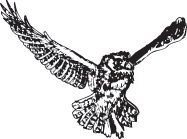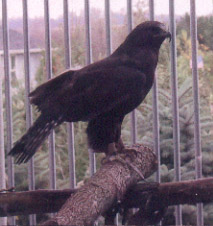

Rough-Legged Hawk
(Buteo lagopus)
Buteos are the largest group of hawks. They have long, broad and rounded wings and short, broad tails. They are able to soar for hours but they usually hunt by the “sitting and waiting” from a tree or utility pole. They eat a wide variety of prey but mice make up the major part of their diet.
The Rough-legged Hawk is almost as large as a Red-tailed Hawk. A Rough-legged Hawk's plumage occurs in two extreme morphs with many intermediate types. The dark morph is almost a solid black-brown color and is more common in eastern North America. The light morph looks similar to a Red-tailed Hawk without the red tail. Rough-legged Hawks are so named because of the feathers on the lower leg, tarsus, down to the toes.

The tarsi of most hawks lack feathers and are scale covered.
Each winter Rough-legged Hawks migrate from the Canadian tundra south in loose flocks to southern Canada and the northern United States. Here they spend their winters usually roosting in conifers and feeding on small mammals, birds and carrion. Rough legs hunt from late afternoon to dusk.
Each spring Rough-legged Hawks return to the open coniferous forest and tundra of Canada. They produce one brood per year of two to seven eggs. They nest in treetops if available, occasionally on steeply banked slopes but rarely on ground. The nest is made of sticks, grass, weed stalks and excrement. It is lined with grass, down and feathers. It has been noted that rough legs have larger clutches in years of high lemming populations. The male does most or all of the hunting from incubation until fledging of the young. Incubation of the eggs begins as soon as the first egg is laid. The first egg will hatch and be 7-10 days older than the youngest, asynchronous hatching. During years of low lemming populations only the first hatched older chicks survive.
Rough legs are inadvertently poisoned by bait intended for mammals and often shot when feeding on road kills in winter.